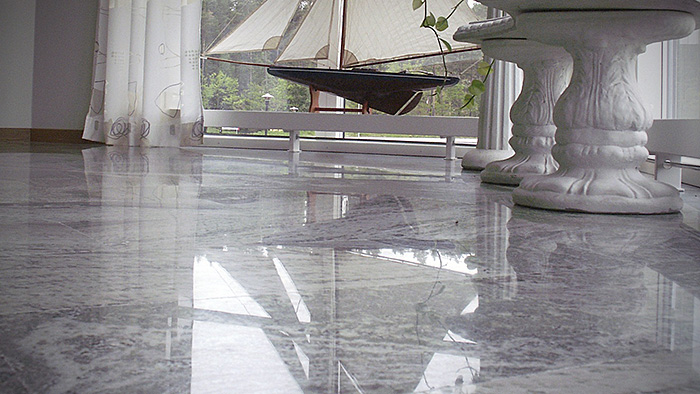Thursday 10th May 2018
How to polish a marble floor?

determinate whether your Marble is: Natural or Cultured.
There are three basic methods you can use to do this all listed below.
Acid method: Pick an inconspicuous area; put few drops of vinegar on the surface to be tested. If it is Natural Marble, you will see some bubbles or fizz, immediately wipe up the vinegar with damp cloth to avoid damage.
Scratch method: In the same hidden spot, lightly scratch the surface with a nail. Use a magnifying glass to see if there is a visible scratch left. Natural Marble scratches easily, while cultured marble does not.
If you are unsure, proceed as thought the Marble is Natural, so you don`t cause damage.
NATURAL MARBLE
Removing any existing stains. Marble is highly porous; stains are caused when liquid seeps into the stone and get trapped. Common spillages like juice, wine, sauces, cooking oils and coffee will all stain your marble surface. To remove fresh stains, use a Damp Microfiber Cloth with warm water and Neutral Detergent, gently rubbing the stain until the area is clean. Then rinse thoroughly.
Removing Stubborn Stains: Dampen Marble with water then apply a few drops of a cleaning chemical, we recommend using Sancitro. Gently rub in with a Stiff Bristled Brush and rising thoroughly, sometimes stubborn stains might require two or three applications.
Always ensure the surface is rinsed thoroughly to avoid damaging the Marble.
 Polishing: After stain removal is complete, before Polishing make sure you have a clean dry surface as Marble is soft and scratches easily, and you don't want to damage it while polishing. Always use a clean, dry Microfiber cloth to gently remove any remaining dirt, dust and grit. If needed rinse well with clean, damp Microfiber cloth then dry the surface well with a clean cloth.
Polishing: After stain removal is complete, before Polishing make sure you have a clean dry surface as Marble is soft and scratches easily, and you don't want to damage it while polishing. Always use a clean, dry Microfiber cloth to gently remove any remaining dirt, dust and grit. If needed rinse well with clean, damp Microfiber cloth then dry the surface well with a clean cloth.
Eco Polishing of your Marble: Use a mixture of Baking Soda and water as a polish. Combine (45 g) of baking soda to (0.9 L) of water and mix well. Then using a clean cloth, apply the mixture to your surface in a thin layer. Allow to dry for about 5 hours. After which using a Microfiber Cloth and warm water to rinse the marble surface you are now ready to dry buff the marble using a clean microfiber or chamois cloth, gently wipe down the marble in wide, circular motions. Move in progressively smaller circles as the surface dries.
For Future Protection Add a Sealant:
Using Sealer N or Lapicur will prevent stains and offer protection to your Marble surface. Follow the instructions carefully. The steps below are for general guidance only.
1. Tape off any areas around the marble surface that are not to be sealed - wood trim, chrome or stainless steel. Use masking tape or plumber's tape.
2. Apply three Coats of Lapicur or Sealer N using a dry clean Flat Microfiber Mop one coat at a time allowing to dry in between coats. For best results use a burnisher in between coats to extend the life of the Sealer giving you a better High Gloss Finish with Ultra Non-Slip properties.
3. By Burnishing you do not have to allow the marble to cure for 6-8 hours, during this time do not use the surface as it is easily damaged if you don’t burnish.
4. Lapicur should be reapplied every 1-2 years, depending on how much traffic your marble surface receives.
Cultured Marble
Cultured marble is much easier to clean than natural marble. Cultured marble is manufactured with a protective coating that makes it much less prone to scratches and damage. However, it still requires attention and care.
1. Remove any stains. Scrub surface stains using a brush with nylon bristles and a Non- Abrasive Scouring Pads.
2. To remove hard water stains, spray Sancitro on the surface and gentle rub in for 5-10minutes then rinse with plain water and wipe with a damp cloth to remove any residue.
3. For general cleaning use Purito or WiWa both are Non Abrasive and Non Streaking floor cleaners designed to give a High Gloss finish in high traffic areas.
4. Polish your Marble. Although this is not necessary as cultured Marble is manufactured with a sealed surface it is recommended to apply a Protective Sealant (Lapicur) every 1 to 2 years to help prevent stains.
5. To give added protection to your Marble Floor from stains and scratches it is recommended to use Dust Control Mats, and to regularly dust and clean your Marble Floors.
Warnings:
- Acids will damage natural marble. Do not use products such as lemon juice or vinegar for cleaning.
- Never use metal scrubbers on marble.
- Acetone is sometimes recommended for cleaning natural marble. DO NOT use it on cultured marble, however, as it will damage the protective gel coating.
- Cultured marble is less delicate but still requires careful cleaning to avoid deep scratches or damage.



